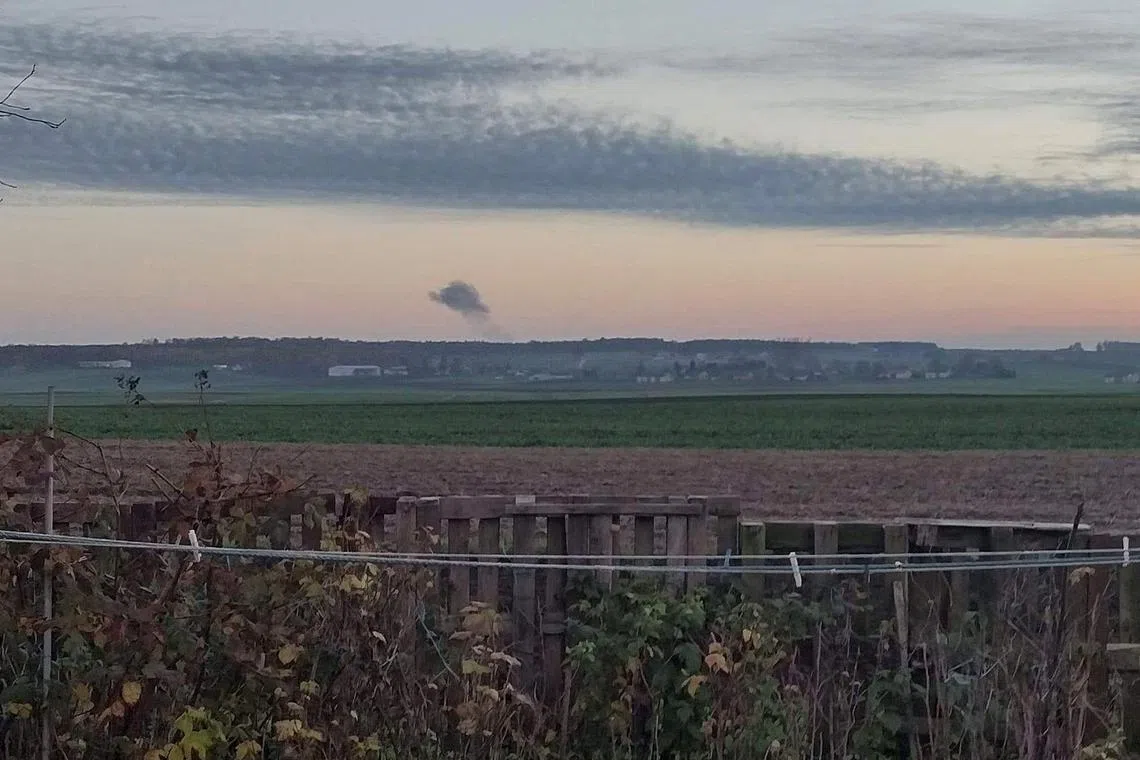War in Ukraine crosses into Poland’s border: What to know about Nato, Putin and Article 5
Sign up now: Get ST's newsletters delivered to your inbox

Smoke rises in the distance, seen from Nowosiolki, Poland, amid reports of Russian rockets landing near Poland's border with Ukraine, on Nov 15, 2022.
PHOTO: REUTERS
Follow topic:
BRUSSELS – If Russia’s invasion of Ukraine was supposed to weaken Nato and stop its eastward expansion – one rationalisation offered by President Vladimir Putin – it seems to have backfired.
Rather than exploit tensions within the alliance, Russia’s war seemingly strengthened it, with Finland and Sweden, two close neighbours of Russia, seeking to join.
The countries that make up Nato have not fired a shot as part of the Russia-Ukraine conflict. But the alliance faces a new test now that Russian missiles were reported to have landed in in Poland
What’s the point of Nato?
Founded in 1949 to protect Europe against Soviet attack during the Cold War, the North Atlantic Treaty Organisation (Nato) has come to represent a fundamental partnership between North America and Europe based on shared political and economic values.
Membership has grown to 30 nations from 12.
What is Article 5?
It’s the pledge of collective defence that, according to Nato, “binds its members together, committing them to protect each other and setting a spirit of solidarity within the alliance”.
It establishes that an attack against one Nato member is considered an attack against all. The pledge enhances the credibility of the alliance’s deterrence strategy by increasing the risks for any potential aggressor.
How often has Article 5 been activated?
Just once, after the Sept 11, 2001, attacks on the World Trade Center and the Pentagon.
The alliance used Airborne Warning and Control System planes to help patrol the skies over the United States. That was followed by ship monitoring in the Mediterranean Sea, participation in the war in Afghanistan and the training of Iraqi soldiers.
What other tools do Nato members have?
There’s also Article 4, which allows for a consultation process if any ally believes the “territorial integrity, political independence or security of any of the parties is threatened”.
Over the years, Article 4 has been invoked seven times, for instance by Turkey, and more recently by eight European countries when Russia launched its attack in February.
The consultation can take many forms. from exchange of information to discussion on joint policies.
How did the invasion solidify Nato?
Two-plus years after French President Emmanuel Macron fretted publicly about the “brain death of Nato” – citing what appeared to be a waning commitment by the US, under then-President Donald Trump – the alliance pulled together to form a mostly unified front against Russia.
The alliance boosted its deployments of forces on the eastern flank, and several member nations supplied military equipment to Ukraine.
Breaking years of reticence, Germany embarked on a major upgrade of its military and vowed to meet Nato’s target of spending 2 per cent of economic output per year on defence.
Ukrainian President Volodymyr Zelensky, while expressing gratitude for the support, said Western nations were not sufficiently united behind helping Ukraine defeat Russia. He cited Nato’s refusal to establish a no-fly zone in Ukraine, a step that could put member countries in military conflict with Russia.
What is Russia’s concern about Nato?
Mr Putin and his government see Nato expanding into what they consider Moscow’s sphere of influence, which diminished after the dissolution of the Soviet Union in 1991. Estonia, Latvia and Lithuania, three former Soviet republics, are now Nato members; Russia, citing its own security, insists that Nato must never let additional ex-Soviet states join.
Is Nato anti-Russia?
Not in the explicit way it used to be anti-Soviet Union.
Since the collapse of the Soviet state, Nato’s role has broadened to include bombing Serb forces during the Bosnia and Kosovo wars of the 1990s and enforcing an arms embargo on Libya in 2011.
Russia moved itself to Nato’s front burner with an initial incursion into Ukraine in 2014 and its full-scale invasion earlier in 2022.
Who hopes to join?
Ukraine and Georgia, both former Soviet republics, applied in 2008.
Nato’s policy of not admitting countries with “unresolved external territorial disputes” weighs against their chances. That’s because, in addition to being present in Ukraine, Russian forces occupy Abkhazia and South Ossetia, internationally recognised parts of Georgia.
Bosnia-Herzegovina has also applied, though domestic division there makes joining an unlikely prospect in the near future.
Sweden and Finland expected little resistance to their sudden desires to join the alliance, but Turkey raised concerns over their relationships with Kurdish groups perceived as terrorists by Turkish officials.
A country can join only with the unanimous consent of Nato members, and 28 alliance members have so far ratified the entry of the two Nordic countries, with Hungary and Turkey as the holdouts.
Why weren’t Finland and Sweden already in Nato?
They had bet that their national security after the Cold War was best protected by staying out.
Finland has spent its 104 years of independence tiptoeing around Russia, with which it shares a 1,340km border; two wars against the Soviet Union between 1939 and 1944 were followed by a policy of deference and self-censorship toward the Soviets that came to be known as Finlandization.
Sweden, neutral for some 200 years, stayed out of both world wars. Through the Cold War, continued neutrality was seen as the best way to ensure its independence.
Public support for joining Nato soared in both Finland and Sweden as a result of Russia’s invasion of Ukraine

